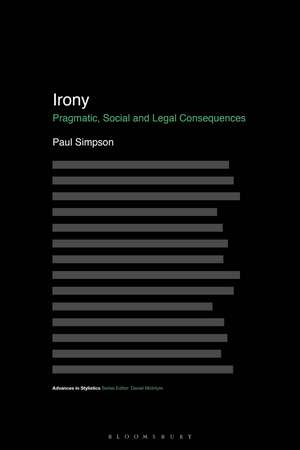Irony: Pragmatic, Social and Legal Consequences: Advances in Stylistics
Autor Professor Paul Simpsonen Limba Engleză Hardback – 7 feb 2024
Din seria Advances in Stylistics
- 18%
 Preț: 180.88 lei
Preț: 180.88 lei - 13%
 Preț: 239.14 lei
Preț: 239.14 lei -
 Preț: 257.03 lei
Preț: 257.03 lei - 13%
 Preț: 257.12 lei
Preț: 257.12 lei -
 Preț: 237.20 lei
Preț: 237.20 lei - 11%
 Preț: 217.82 lei
Preț: 217.82 lei - 13%
 Preț: 239.21 lei
Preț: 239.21 lei -
 Preț: 257.68 lei
Preț: 257.68 lei -
 Preț: 257.97 lei
Preț: 257.97 lei - 13%
 Preț: 257.68 lei
Preț: 257.68 lei - 13%
 Preț: 256.59 lei
Preț: 256.59 lei -
 Preț: 254.75 lei
Preț: 254.75 lei -
 Preț: 224.11 lei
Preț: 224.11 lei - 13%
 Preț: 257.97 lei
Preț: 257.97 lei - 13%
 Preț: 256.85 lei
Preț: 256.85 lei - 23%
 Preț: 200.71 lei
Preț: 200.71 lei - 22%
 Preț: 223.67 lei
Preț: 223.67 lei - 23%
 Preț: 229.86 lei
Preț: 229.86 lei - 21%
 Preț: 218.18 lei
Preț: 218.18 lei - 23%
 Preț: 199.45 lei
Preț: 199.45 lei -
 Preț: 198.12 lei
Preț: 198.12 lei - 23%
 Preț: 192.19 lei
Preț: 192.19 lei -
 Preț: 254.84 lei
Preț: 254.84 lei
Preț: 569.53 lei
Preț vechi: 662.25 lei
-14% Nou
Puncte Express: 854
Preț estimativ în valută:
109.01€ • 118.45$ • 91.63£
109.01€ • 118.45$ • 91.63£
Carte disponibilă
Livrare economică 31 martie-14 aprilie
Preluare comenzi: 021 569.72.76
Specificații
ISBN-13: 9781472579454
ISBN-10: 1472579453
Pagini: 256
Dimensiuni: 156 x 234 mm
Editura: Bloomsbury Publishing
Colecția Bloomsbury Academic
Seria Advances in Stylistics
Locul publicării:London, United Kingdom
ISBN-10: 1472579453
Pagini: 256
Dimensiuni: 156 x 234 mm
Editura: Bloomsbury Publishing
Colecția Bloomsbury Academic
Seria Advances in Stylistics
Locul publicării:London, United Kingdom
Caracteristici
Examines irony in terms of its pragmatic, social and legal consequences, grounded in real instances of ironic communication from the private and public spheres
Notă biografică
Paul Simpson is Baines Professor of English Language at the University of Liverpool, UK.
Cuprins
1. Irony as Social Action2. Locating Irony in Language and Context3. Building a Model of Irony4. Irony: From Private to Public Sphere 5. Irony and its Consequences in the Public Sphere6. Irony and the Law7. Re-Evaluating Irony as Figurative LanguageBibliographyIndex
